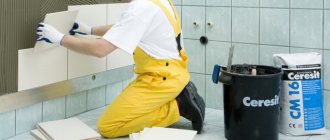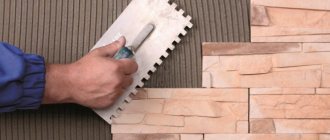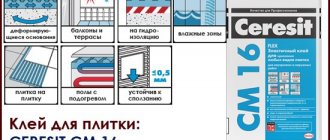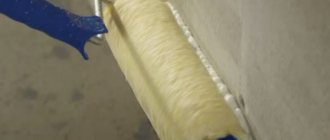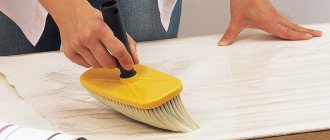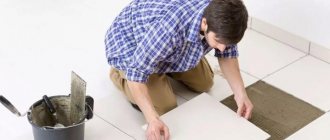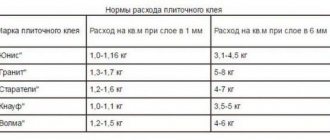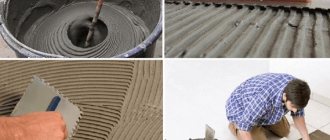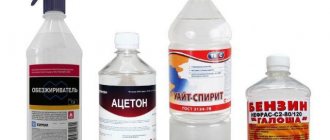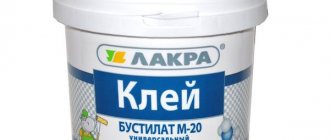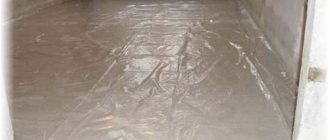Ceramic tiles are a popular material for covering various surfaces. But in order to be able to lay tiles on the surface efficiently, it is important to choose the optimal adhesive solution. At the same time, I most often use dry mixtures; they must be prepared according to the rules in order to obtain all the necessary characteristics. How to dilute tile adhesive correctly will be discussed below.
What does glue contain?
The rules for diluting tile adhesive will depend on what components were used in the production of the mixture. Tile material is usually glued using cement glue. To improve moisture resistance and frost resistance, special substances are added. The main elements are Portland cement and quartz sand. Types can be created with the addition of PVA, which helps improve elasticity.
Other types of adhesives for walls and floors can be produced using the following substances:
- Latex, which is a binding agent, is used for its plastic properties;
- Epoxy resin to work with wood, ceramic and metal substrates, high water resistance;
- The polyurethane component helps improve adhesion to substrates;
- Synthetic resin, reduces drying and setting time;
- Synthetic rubber is required for the production of liquid nails.
To improve moisture resistance and frost resistance, special substances are added.
How to make your own dry mixture
If circumstances are such that there is no possibility of purchasing a ready-made adhesive mixture, then it is quite possible to prepare it yourself. To do this, you need to have Portland cement and fine sand available; if the latter comes in lumps, then they should be broken and the sand sifted through a sieve.
In addition to these two components, to add strength to the mixture, you can add PVA or silicate glue to it. You can find out how to make PVA glue at home and how long it takes for PVA glue to dry from our reviews.
The composition of the dry mixture should be the proportion: one share of cement to five shares of sand.
- Next, you should pour water into a previously prepared and cleaned container.
- Gradually add the dry mixture to the water, stirring constantly.
- Also at this moment you can add glue to the prepared solution.
Further actions are identical to those performed when preparing a solution using factory mixtures. After the solution has turned out to be a homogeneous mass without lumps, it needs to be allowed to brew and then mixed again. After this, the resulting solution is ready for use.
The importance of component selection
Selecting the correct quantity and type of elements mixed into the mixture has a direct impact on the resulting properties of the solution. At the same time, temperature indicators and cooking conditions also help improve quality. If you take into account all the points, you can reduce the consumption of the product and increase the adhesion strength and durability of gluing the tiles to the surface. It is important to consider the following features:
- Water, you only need to use clean and purified water, that is, you cannot use the technical type, it contains various alkalis and impurities that can change the characteristics of the composition;
- Temperature readings when you decide to stir the product can vary from +5 to +40 degrees, but room temperature is the best option. Under such conditions, the setting of the solution will occur at the correct time;
- The same temperature of the mixture and water, in order to achieve similar indicators, they are placed in a room where they will work for several hours, optimally so that their temperature is equal to room temperature.
In addition, it will be important to use a clean container so that no contamination affects the setting process and the composition of the solution. You also need to dilute the components with cleaned tools.
Only clean and purified water should be used.
How to dilute tile adhesive
When diluting tile adhesive, follow these rules:
- all components must be at room temperature before kneading;
- when preparing glue, use tools that are free of dirt and thoroughly washed;
- avoid using process water when mixing due to the content of other impurities that negatively affect the initial characteristics of the mixture; Clean household water is best;
- wear gloves to protect the skin of your hands from contact with the solution and a respirator to prevent dust from entering your respiratory tract;
- Prepare the tools necessary for mixing: trowels, containers, mixers, rectangular blades, drill mounts.
To properly dilute tile adhesive, read the manufacturer's instructions. It indicates the stages, methods and proportions of diluting the mixture to achieve the desired consistency. The standard kneading algorithm consists of the following steps:
- For 20 kg of dry tile mixture, add 5 liters of clean water, use a large container;
- Pour the powder composition into the container in parts, constantly stirring the solution - this way you will avoid too much dust;
- Stir the resulting mass constantly until the composition is homogeneous; it is important not to leave lumps or structural separations in the solution;
- Leave the solution to brew, after a few minutes stir the composition again;
- The mixture is ready for application.
Properly prepared tile adhesive is slightly moist, but its consistency is not liquid. To test, use a trowel to scoop out a small amount of the mixture, turn it over and hold it in this position for a while. If the resulting mixture holds and does not drain, you can safely begin laying. If the solution falls in a layer, there is a larger amount of dry component in the adhesive solution. The situation is easily corrected by adding water.
The preparation of the adhesive mixture, like other tiling works, is recommended to be carried out at a temperature range of 10-25 degrees Celsius. The suitability of the finished solution remains for 3-4 hours. The dried mixture is not used when laying tile products. To prevent it from drying out quickly, stir the adhesive mixture periodically, adding a small amount of liquid if necessary.
Preparing the necessary materials
The choice of what to mix the mixture with water is important. When working with a small volume of adhesive solution, it will be enough to use a rectangular trowel that can handle a ten-liter bucket of water. When using the manual method of mixing elements, it is important to carefully ensure that all substances are mixed together and that no mixture remains on the walls of the container. Work carefully to avoid lumps. If the work area is large, then it is better to use a drill with a special attachment, or a construction mixer.
The nozzle is used specifically for solutions; it should not be confused with the nozzle for paint and varnish products.
Work carefully to avoid lumps.
General notes and tips
When stirring the glue, do not rush. The consistency of the resulting solution should be accurately assessed. To do this, place a small amount on the trowel, after which the tool is tilted strongly. If the adhesive solution falls off in one piece, you need to increase the amount of water.
Attention! You can increase the amount of liquid only when mixing the glue for the first time. After the second mixing, if the glue thickens during work and begins to clump, you cannot add water. The solution should be mixed with a mixer. This will restore its consistency for a while, which will allow you to finish the work.
A dripping, sliding solution indicates that it is necessary to wait some time for partial setting, and prepare the next portion with less liquid. If the adhesive composition on the trowel holds firmly and has a uniform consistency, you can work with such a mixture with a guarantee of a good result.
As can be seen from the above, there is nothing complicated or magical about mixing high-quality tile adhesive. All you need to do is pay attention to detail and carefully follow the manufacturer's effective techniques and instructions.
Step-by-step instructions for preparing the solution
Obtaining the desired consistency of the solution is possible if you act in stages and know the rules of stirring. The process includes the following steps:
- Having prepared the required volume of water, the mixture is gradually poured into it; you cannot do the reverse order, this contributes to the formation of lumps. When the mixture is poured out, the mixer is already turned on;
- This order of adding ingredients has another advantage. A two-layer solution concentration is formed. In the upper part the density is higher and in the lower part less, but it changes while the upper half is being applied, and mixing will also be faster;
- Manufacturers advise that the solution be mixed twice. The first helps to connect the elements with each other, then they leave it for a certain period of time, usually it does not exceed 5 minutes, so that the composition sets. Next, mix the glue again with a mixer; this method works to restore the mass and extends the period of applying the substance to the surface to 20-60 minutes;
- The speed of setting the revolutions on a power tool can be prescribed by the manufacturer in the instructions, but is standardly selected at 300 rpm. This is important, otherwise a lot of air will get into the solution, and the adhesion of the materials will become worse. The mixing time should not be long so as not to create too liquid a composition.
Some products state that you can only use the manual method for preparation. The proportions of the components must be observed.
The speed of setting the revolutions on a power tool can be prescribed by the manufacturer in the instructions, but is standardly selected at 300 rpm.
The article described in detail how to dilute tile adhesive in order to obtain a high-quality mixture that will create a strong connection between the tile and the surface. There are many nuances in the process that should be taken into account, otherwise you may encounter the problem of poor adhesion and poor durability of the installation. The solution is influenced by the temperature of the air, water and mixture, as well as the correct selection of mixer speed, component ratios, and water quality.
What mixtures do you have to work with?
When laying tiles on the floor, depending on the characteristics of the base and the allocated repair budget, different types of ready-made mixtures are purchased.
- The cement mixture is convenient, widespread, and the price is attractive to the consumer. The components included in its composition are characterized by the same dispersion; the solution can be mixed quickly and evenly. It is imperative to follow the manufacturer's instructions to properly dilute cement-based tile adhesive.
- Two-component compositions have low hardening times. It is important not only to know how to dilute tile adhesive of this class, but also to clearly determine the proportions in order to prepare the mixture in small doses. This will allow you to work at a stable rhythm when laying tiles, without worrying that the prepared portion of the mortar will dry out and become unusable.
- The third type of glue is epoxy. It is not diluted with water. A liquid base and a reaction catalyst are purchased. To prepare tile adhesive as a solution for application to a wall or floor, you need to mix the two components and thoroughly grind them together until a thick, uniform mass is formed.
The most important thing about how to dilute tile adhesive with water is not only to follow the proportions and recommendations of the composition manufacturer, but also to follow a number of rules and techniques. If all preparation parameters strictly comply with the standards, the composition will not only have the declared characteristics, but will also guarantee good adhesion.
Possible types of glue
In addition, knowing how to carry out work correctly, you can prepare glue that will allow you to work at a more relaxed pace.
Choosing the right adhesive
In order to choose the right adhesive composition, we are guided by the following rules:
- preference should be given to proven brands;
- select glue depending on the task at hand;
- pay attention to the date of manufacture of the composition and its shelf life;
- Warehousing and storage conditions can also affect the quality of the product.
The standard adhesive mixture should allow individual fragments to be adjusted within 15-20 minutes.
When choosing an adhesive, you should also pay attention to the fixing properties and degree of adhesion of the adhesive mixture.
Following the instructions for preparing glue on the packaging is the main requirement.
Types and characteristics of adhesive compositions
Modern manufacturers of building materials offer several types of mixtures intended for facing work. These include:
- universal adhesive - made on a cement base using additives that give the composition the necessary functional characteristics;
- reinforced - capable of reliably fixing heavy cladding elements;
- moisture resistant - suitable for finishing work in rooms where there is a high level of humidity;
- polymer - intended only for interior finishing work, as it does not tolerate temperature fluctuations and ultraviolet radiation;
- modified - a plastic mixture characterized by increased performance characteristics due to the addition of additives.
According to the method of preparation, all mixtures are divided into adhesive mastics and dry mixtures. Mastics do not require preliminary preparation - they are produced in the form of a paste, ready for use.
Recommendations
Do not rush while stirring. It is necessary to accurately assess the consistency of the solution. To do this, dial a little on the trowel, and then tilt the tool. If the solution falls off in pieces, then you need to increase the amount of water.
The amount of liquid should be increased only when mixing the glue for the first time. After 2 mixings, if the glue thickens or begins to clump during work, then you should not add water. It is advisable to use a mixer to mix the solution. This is necessary to restore its consistency for a while, which will help finish the job.
If the solution flows or slides, then some time is needed for partial setting, and the next portion is prepared with the required amount of liquid. If the adhesive composition holds securely, then the mixture can be used.
10 tips for beginners on how to dilute tile adhesive
It is very difficult for beginners in the construction business to properly dilute and use tile adhesive, so we decided to collect the most useful information on this topic together and present it as an advisor.
Tips for mixing tile adhesive:
- Don't overmix.
The optimal volume of the finished mixture should cover 1-1.5 m2 of surface.
- Do not store the finished glue for too long.
If the mixture is left in the open air for more than 240 minutes, it completely loses its adhesive properties.
- Do not pour all the powder in at once.
You will get a single layer that cannot be crushed even with a mixer at high speeds.
- Stir again before use.
This will remove the top frozen film and make the solution homogeneous.
- Observe temperature conditions.
Tile adhesive will “feel comfortable” within 12-24 degrees. With large deviations from the norm, the adhesiveness will decrease significantly.
- Do not use glue with a thick film.
An overstayed solution will not be able to provide high-quality adhesion.
- Glazed tiles require a thinner solution.
This type of tile is characterized by high moisture absorption rates, so the adhesive must be diluted to a thinner consistency.
- The glue should not harden immediately.
If, when applying the solution to the surface, it instantly hardens, then the glue has expired and cannot be used.
- Don't delay making adjustments.
This means adjusting the tiles that are already sitting on the adhesive. The first 10-15 minutes are considered the optimal time. after posting.
- Don't chase low prices.
Even if a trusted brand costs 30-40% more, you will be completely confident in the quality of such a product.
If you follow the tips listed, even a beginner will be able to mix tile adhesive at the highest level without any problems. High-quality tile adhesive is the key to the durability of your tiles. Make your choice wisely and you can forget about your problems for at least 25-30 years.
The influence of glue composition on the preparation method
The composition of the adhesive determines how the solution applied to the tiles and walls will be prepared. Today there are several types of tile adhesive, for example, Plitonit, Eunice glue and the like. To avoid making mistakes with the technology for its preparation, it is recommended that you read the appropriate instructions on the label with the bag of adhesive.
Thus, the material in the form of a paste is a ready-made component. There is no need to dilute it. It is immediately ready to use. You may need to mix it thoroughly with a mixer before using.
Its advantage is that it does not dry so quickly. Due to this, the work of installing tiles is carried out slowly and carefully. As for two-component compositions, they are prepared immediately before starting work. This glue has excellent elasticity.
Advice! If after work you have leftover glue left over, use it. For example, you can cover up a crack, a pothole, or hide any other unevenness.
When dry powder remains after work, it must be stored in a dry place. Thanks to this, after a while, it can still be used. When moisture gets into it, the entire composition turns into stone, suitable for garbage.
Conclusion As we have seen, the technology for diluting glue with your own hands is indeed very simple. It does not require special skills or knowledge. By following the tips provided in this article, you will be able to do this job perfectly.
We hope that this material helped you expand your knowledge base, and perhaps discovered something new for you. Additionally, we invite you to watch a video that clearly demonstrates this work.
Preparing tile adhesive: secrets and more
“What doesn’t salt is not salt, what doesn’t stick is not glue,” so goes the old saying.
In layman's terms, this means that the adhesive, in particular tile adhesive, must live up to its name and at least perform the functions assigned to it. Namely, to reliably fasten ceramics of any kind to the surface of walls or floors. To prepare glue, use only clean containers and tools.
More and more people are striving to make repairs in their homes with their own hands without the services of professionals, especially since the development of the media and the Internet, among other things, provides home craftsmen with high-quality information and detailed instructions, following which they can perform almost any type of work.
If you are planning to start renovating your bathroom in the near future, then most likely you are faced with the task of laying tiles. This material today is known for its excellent technical characteristics, which make it possible to use tiles not only in the bathroom, but also in other rooms.
For laying tiles, a special tile adhesive is used, which is mainly sold in dry form. In this article we will tell you how to dilute tile adhesive so that the repair is carried out with high quality.
Types of adhesive compositions and their subtleties
In order to fully understand this process and successfully prepare tile adhesive, you need to consider the most basic types of adhesive compositions. The modern market offers a huge selection of mixtures onto which tiles are glued, but the most basic of them are:
- moisture resistant. Typically used in the bathroom, swimming pools or saunas, that is, on surfaces that are constantly in contact with water. This glue is moisture-resistant and water-repellent and therefore does not collapse from exposure to moisture;
- cement universal composition is the most popular. It’s easy to knead it by studying the instructions on the package and making the correct consistency of water and dry matter;
There are also types that, in addition to the main task, simultaneously perform the function of grouting, which very conveniently reduces work time.
Common types of glue: specifics of mixtures
The main thing you need to understand is that the choice of adhesive composition is determined by certain factors:
- total cladding area;
- type and characteristics of ceramics;
- material and condition of the base intended for cladding.
It is necessary to carefully understand the types and specifics of applying glue
According to the classification, tile adhesive is divided into five groups:
- Adhesive for indoor work. The composition contains a minimum amount of additives, thanks to this, the price for such mixtures is the most reasonable. It is used for laying ordinary tiles on a surface made of concrete or cement-sand mortar.
- Universal compositions. Used for laying standard-sized ceramics both indoors and outdoors.
- Adhesive intended for laying floor tiles. Due to the large number of plasticizers in its composition, it has increased fluidity, which makes it impossible to use the adhesive on vertical surfaces.
- Compositions with a high adhesion rate. Suitable for working with large format ceramics on non-standard surface types.
- Adhesive with a high degree of moisture resistance. The presence of a hydrophobic modifier in the mixture allows the use of such tile adhesive in swimming pools and fountains.
Preparing to mix glue
First of all, you need to check the condition of the adhesive mixture, it should be dry, at room temperature, preferably there should be no lumps in the dry glue. It is also better to warm the water for mixing glue to room temperature; it should be clean. The mixing containers must also be clean and free of dried glue residues from previous mixing.
If the amount of glue is small, mixing can be done using a trowel, but it is much faster and more efficient to use a mixer attachment for a drill. When buying such an attachment, choose a model for cement mortar, as there are also attachments for stirring paint.
Remember that when mixing the glue, a large amount of dust can be generated, so it is recommended to use a respirator
. Protective gloves and glasses will also be useful. It is better to prepare glue in a robe or in clothes that you don’t mind ruining, since traces of glue are quite difficult to remove from fabric.
